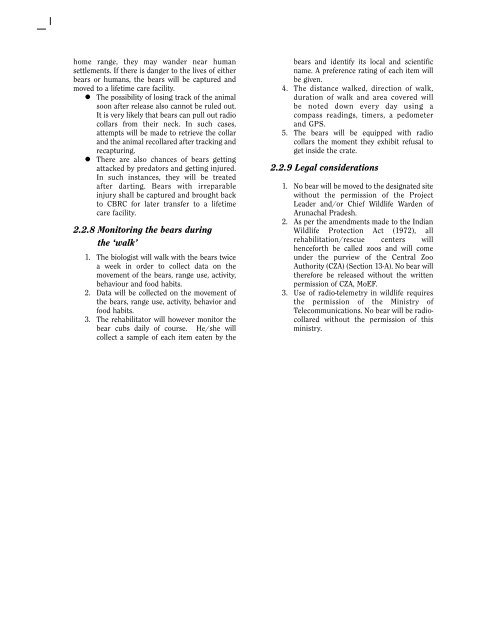Walking The Bears.pdf
Walking The Bears.pdf
Walking The Bears.pdf
- TAGS
- walking
- www.ifaw.org
You also want an ePaper? Increase the reach of your titles
YUMPU automatically turns print PDFs into web optimized ePapers that Google loves.
home range, they may wander near human<br />
settlements. If there is danger to the lives of either<br />
bears or humans, the bears will be captured and<br />
moved to a lifetime care facility.<br />
� <strong>The</strong> possibility of losing track of the animal<br />
soon after release also cannot be ruled out.<br />
Itisverylikelythatbearscanpulloutradio<br />
collars from their neck. In such cases,<br />
attempts will be made to retrieve the collar<br />
andtheanimalrecollaredaftertrackingand<br />
recapturing.<br />
� <strong>The</strong>re are also chances of bears getting<br />
attacked by predators and getting injured.<br />
In such instances, they will be treated<br />
after darting. <strong>Bears</strong> with irreparable<br />
injury shall be captured and brought back<br />
to CBRC for later transfer to a lifetime<br />
care facility.<br />
2.2.8 Monitoring the bears during<br />
the ‘walk’<br />
1. <strong>The</strong> biologist will walk with the bears twice<br />
a week in order to collect data on the<br />
movement of the bears, range use, activity,<br />
behaviour and food habits.<br />
2. Data will be collected on the movement of<br />
the bears, range use, activity, behavior and<br />
food habits.<br />
3. <strong>The</strong> rehabilitator will however monitor the<br />
bear cubs daily of course. He/she will<br />
collect a sample of each item eaten by the<br />
bears and identify its local and scientific<br />
name. A preference rating of each item will<br />
be given.<br />
4. <strong>The</strong> distance walked, direction of walk,<br />
duration of walk and area covered will<br />
be noted down every day using a<br />
compass readings, timers, a pedometer<br />
and GPS.<br />
5. <strong>The</strong> bears will be equipped with radio<br />
collars the moment they exhibit refusal to<br />
get inside the crate.<br />
2.2.9 Legal considerations<br />
1. Nobearwillbemovedtothedesignatedsite<br />
without the permission of the Project<br />
Leader and/or Chief Wildlife Warden of<br />
Arunachal Pradesh.<br />
2. As per the amendments made to the Indian<br />
Wildlife Protection Act (1972), all<br />
rehabilitation/rescue centers will<br />
henceforth be called zoos and will come<br />
under the purview of the Central Zoo<br />
Authority(CZA)(Section13-A).Nobearwill<br />
therefore be released without the written<br />
permission of CZA, MoEF.<br />
3. Use of radio-telemetry in wildlife requires<br />
the permission of the Ministry of<br />
Telecommunications.Nobearwillberadiocollared<br />
without the permission of this<br />
ministry.

















